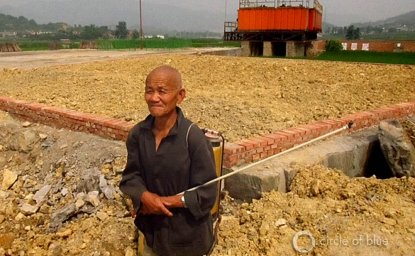The following has been adapted from an article in the forthcoming China Environment Series 12.
On September 7, 2012, the largest of at least seven Mekong River hydroelectric power stations came online in Pu’er, Yunnan—a southwestern province that is China’s most biodiverse. The Nuozhadu hydroelectric station, Asia’s tallest dam, turned on the first of its nine generating units that will eventually supply 23.9 billion kilowatts of electricity by 2014.
Perhaps by chance, the dam is located at the epicenter of China’s coffee growing boom. Pu’er began turning into China’s coffee capital after a major price bubble temporarily collapsed the eponymous Pu’er tea market in 2008. The tea has since rebounded, but coffee continues to thrive in Pu’er. The land acreage devoted to coffee cultivation in the province has doubled since 2008, and officials want to increase Yunnan’s coffee output fivefold by 2015. But the confluence of the Pu’er area’s new dam, coffee boom, and a province-wide three-year drought are emblematic of China’s pressing confrontation between water, energy, and food. Such a confrontation could make the official coffee production target unreachable, as well as detrimentally impact other agriculture production in the province.
Whether by coincidence or design, the reservoir created by the dam will undoubtedly serve as one source of water for agriculture, including expanding coffee industry in the area, perhaps even protecting it from the threat of drought that has plagued the rest of the province.
The local government has been promoting the dam’s benefits as a source of irrigation for all types of farming, and encouraging the people displaced by the reservoir to enter the coffee growing industry.
Water Scarcity: “The Four D’s” of Yunnan’s Water-Energy-Food Choke Points
In a striking example of China’s water-energy-food choke points, Yunnan’s water resources are being threatened by a confluence of four D’s: Drought, Dams, Development, and Deforestation. Beginning in 2009, a devastating three-year drought that left 8 million people without water in 2010 has also wrought havoc on the province’s agriculturally based economy. Yunnan is a leading producer of China’s fresh flowers, tobacco, tea, sugar, and coffee, and the drought halved yields for all of these crops. The drought also has caused a 47 percent decrease in reserve hydropower capacity, undermining the investments made in Yunnan’s 21 dams.[i]
According to Liu Xiaokang of the Yunnan Green Environment Development Foundation, an NGO in Kunming, climate change has been a contributing factor in changing weather patterns, but the most affected areas of Yunnan are those with the fastest rate of development and most extensive deforestation.
The largest culprit behind Yunnan’s deforestation has been the rise of eucalyptus and rubber tree cultivation in the province. Since 1976, over 67 percent of Yunnan’s rainforests have been lost due to rubber plantations, significantly reducing the region’s biodiversity. "Such large-scale deforestation removes the valuable ecological services natural forests provide," says Liu Wenyao, an ecologist at the Xishuangbanna Tropical Botanical Garden, a research institute of CAS in Menglun in southwestern Yunnan. "The impact of deforestation on hydrological processes becomes particularly acute during prolonged droughts." Such hydrological impacts are particularly relevant to Chinese coffee farmers, as many of them practice monoculture rather than cultivating shade-grown coffee. Despite the ongoing logging ban, hillsides were recently observed being clear cut of trees to make way for coffee growing and tree plantations.
China’s Imbalances: Putting Yunnan in Context
These confrontations in Yunnan are just a smaller piece in the larger story of the water-food-energy nexus in China. The choke points in Yunnan are being impacted by broader national development and resource trends. Indeed, China’s development patterns and uneven distribution of water are creating other imbalances. The far western provinces in China, including Yunnan, have long lagged behind the coastal provinces in terms of economic development. The eastern provinces, which have benefitted from their 25-year head-start in economic development, are demanding more and more electricity as they grow. In fact, electricity shortages could strangle China’s still-booming coastal development. Meanwhile, the grain belt in north-central China is rich in coal but lacks the water necessary to fully develop the resource while maintaining its wheat and corn output.
Engineering Solutions
Instead of addressing the water and energy shortages through demand management techniques, China’s policymakers are undertaking two huge infrastructure projects to “feed the beasts” and keep the economy going. The first is the South-North Water Transfer Project, the largest water infrastructure project in the world, which will eventually transfer 35 billion cubic meters of water every year from China’s wet south to its dry north.[ii]
The second project, the West-East Electricity Transfer Project—initiated in the Tenth Five-Year Plan (2000-2005)—was designed to bring investment and development to China’s lagging west while satisfying the growing electricity needs of the country’s eastern provinces. The project is expanding the western provinces’ electricity-generating capacity, primarily through the construction of new coal bases and hydroelectric dams. To get this power to the electricity hungry coasts, three electricity-transmission corridors have been constructed.

China's West-East Electricity Transfer Project. Click the map to learn more.
The ongoing three-year drought in Yunnan has already impacted Guangdong. In the summer of 2011, factories in Guangdong province were asked to cut power at different hours of the day for varying lengths of time because dams in China’s southwest were producing electricity far below capacity—some as low as 10 percent of normal daily output. The Nuozhadu Dam in Pu’er is expected to send two-thirds of its electricity to Guangdong. All these signs do not bode well for farmers who may come to depend on reservoirs for water during dry spells. Indeed, the looming water shortage in Yunnan Province highlight the importance of agricultural water conservation programs such as the Starbucks’ Coffee and Farm Equity (C.A.F.E) standards.
Yunnan’s Coffee Buzz
Although coffee cultivation is but a drop of water in terms of Yunnan’s overall agricultural production, the province constitutes China’s only significant coffee producting region, accounting for 98 percent of the country’s coffee production, 70 percent of which is exported. Coffee production in the province has soared and currently, Pu’er produces 60 percent of Yunnan’s coffee. Since 2008, land area in Pu’er region used for coffee production has doubled from 14,000 hectares to 28,000 in 2011. That number is expected to double again by 2015.
Despite this remarkable growth, demand has still outstripped supply. Over the same period, coffee bean prices have doubled, rising from 16 yuan a kilo to 30 yuan a kilo. These high prices give farmers incentives to switch from tea to coffee cultivation/production, and to clear forested areas for its production.
While certainly good for Chinese coffee drinkers, there are questions about the sustainability of Yunnan’s coffee boom. Most of the coffee grown in Yunnan is sun grown, which requires more chemical fertilizers than shade grown coffee to achieve similar yields. Notably, Starbucks only purchases shade-grown coffee, which underscores the potentially large environmental benefits of the company’s program to promote sustainable coffee farming in the province.
Starbucks in China
Starbucks is the face of the coffee boom in Yunnan. The company first opened coffee houses in Mainland China in 1999, but it was not until 2006 that Starbucks considered sourcing coffee beans from China. . In 2009, the company rolled out its first line of coffee featuring beans from Yunnan, called “South of the Clouds” (a literal translation of the name Yunnan).
Since then, Starbucks has been working with local governments, firms, and the Yunnan Academy of Agricultural Science (YAAS) to expand its coffee production, increase quality, and improve sustainability. In 2010, Starbucks signed an agreement with YAAS and the Pu’er city government to establish its first coffee bean farm in the region. In addition, the agreement included plans for a coffee development center, a farmer support center, and coffee processing centers. In 2011, Starbucks set up a local joint venture (JV) with Ai Ni Group—an established coffee operator and agricultural company in Yunnan—to expand its coffee sourcing network in the region and to more fully implement “best practice” coffee processing methods.
Coffee and Water
Coffee growing and processing is a surprisingly water-intensive. Beyond brewing the ubiquitous drink, water is needed to grow the coffee plants and process the beans. Coffee processing can require substantial volumes of water which produces coffee effluent -- industrial wastewater that must be properly treated. Because so much of the coffee plant is discarded during the processing phase, the virtual water content of coffee is much higher than one might expect. Dutch scientists have estimated that it requires 140 liters of water to produce one cup of coffee. Well aware of coffee’s water intensity and other problems associated with coffee cultivation in the developing world, Starbucks began implementing a set of environmental, social, and economic guidelines in 2004 to source ethically produced coffee globally. Called Coffee and Farm Equity (C.A.F.E) standards, and introduced in 2011, these standards include water-conservation measures in growing and processing and require proper waste-water disposal techniques.
Launching the C.A.F.E. Standards in Pu’er
Since Starbucks entered into Yunnan, it has been slowly encouraging its local suppliers to follow C.A.F.E. Practices. The company has publicly stated that it hopes to source 100 percent of its coffee from C.A.F.E. certified farms by 2015.
A consistent source of water makes it easier for farmers to stick to the C.A.F.E. Practices. Abundant water means a higher concentration of naturally occurring climate-change impact mitigators, like shade trees. The trees improve soil quality, water retention, and crop yields while reducing the need for fertilizers. Furthermore, Starbucks’ farmer support center in Pu’er will likely encourage farmers to become more water efficient and sustainable. One of their primary functions is to ask farmers questions like “what are your yields, problems, pests, etc.” and providing advice on how to improve.
The Brewing Water-Energy-Food Challenges Beyond Yunnan
Yunnan is a microcosm of the intertwined challenges facing China; climate change, strained water resources, and rising energy and food demand to meet the demands of the world’s largest country are together forming a Choke Point that cannot be ignored. And, with its vast range of topographies, Yunnan is especially vulnerable to these Choke Points and to the effects of climate change.
But Starbucks’ C.A.F.E. Practices, if they can be implemented successfully, offer farmers the tools they need to adapt to and withstand these Choke Points, while simultaneously reducing their industry’s strain on the environment. The market incentives in Starbucks’ C.A.F.E Practices provide a possible model for sustainable agriculture reforms in China at large. China’s leaders have been masterful in using market incentives to reform agriculture in the past—let’s hope they can do it again.
David Tyler Gibson is currently a research assistant at the Woodrow Wilson Center’s China Environment Forum. He can be reached at: dtg2007@gmail.com.
[i] Reserve Hydropower Capacity is the total amount of generating capacity minus the capacity that is currently being utilized.
[ii] A project originally conceived by a whimsical comment made by Chairman Mao: “Southern water is plentiful, northern water scarce. If at all possible, borrowing some water would be good.”







